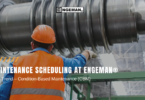Regardless of its type and form of application, maintenance can be defined as a set of procedures performed periodically on systems, machines and equipment. These interventions have as main objective to keep the devices in full operation and to ensure that all their functions are performed effectively.
Throughout history, maintenance has undergone many modifications until it reaches the most sophisticated processes in existence today. Over the years, new technologies have been incorporated and processes, techniques and procedures have been developed. All of this has made repair interventions faster and more effective.
There are several lines and types of maintenance and each of them has a way of being applied and a right time to be performed. Each company has its particularities and needs to know well the types of maintenance to know which will be the most suitable for their business. In this article, we will talk about the types of maintenance, advantages and application of each of them. Keep reading it!
Corrective Maintenance
This type of maintenance is the oldest and has existed since before World War II, when the industry was not mechanized and repairs were carried out only when the equipments broke. Corrective Maintenance is also known as Reactive Maintenance, for addressing machine problems only when they appear, as a way of reacting to the problem. As its name says, corrective maintenance acts on the equipment to correct failures, breaks or defects, performing interventions that make the machines return to normal operation.
Contrary to what many say, corrective interventions are not necessarily emergency procedures, as they can also be performed to correct and restore equipment performance.
Types of Corrective Maintenance
Corrective maintenance can be divided into two distinct types.
· Unplanned Corrective Maintenance: correction of a random failure where there is no time for scheduling and preparation of the repair service to be performed. It is represented by corrections of breaks that keep machines out of operation. They are expensive, time-consuming and lead to losses in production or services.
· Planned Corrective Maintenance: performed when the loss of performance of the machines is detected — in this case, there is time to program and plan the intervention. It is cheaper than unplanned tasks, but generates losses due to the equipment’s performance drop. It is advised to be carried out as soon as possible to prevent failures from occurring.
Corrective Maintenance is not the most recommended because it only aims to correct failures and return the equipment to full operation. Therefore, it generates greater expenses with corrections and last-minute parts, lost team working hours, as it is often necessary to stop the production line, in addition to wear and tear for the entire company.
Preventive Maintenance This type of maintenance is well known and widely used. Preventive maintenance aims to prevent breakdowns and the appearance of failures in machines and components.
Preventive tasks are performed periodically, being fulfilled before malfunctions and failures occur, ensuring that machines maintain their operation effectively and reliably.
All preventive procedures are scheduled and must be performed periodically, following a previously determined interval.
Generally, preventive interventions are carried out according to the use of the machine, taking into account factors such as hours of use, mileage, operation cycles and others.
Because it is a fully planned maintenance, supervisors are not surprised. This avoids income drops, stops for repairs and, mainly, decreases maintenance costs.
It is very important to know that this alternative does not reduce component changes in a given equipment, but allows its service life to be maximized. Among the main advantages of preventive maintenance, the following can be highlighted:
· reduction of aging and degradation of equipment;
· increase service life;
· decrease in shutdowns and corrective tasks;
· reduction of risks and accidents;
· reduction of maintenance costs.
Predictive Maintenance
Predictive maintenance is defined by the actions that are made on the machines according to changes in control parameters. It is known in Maintenance Engineering as a method that aims to indicate, through software and equipment, the operating conditions and performance of a machine in real time.
In other words, predictive maintenance provides monitoring of the device in question. It is applied to the monitoring of many conditions, such as electrical, mechanical, hydraulic and pneumatic.
Through this control of parameters and metrics, it is possible that those responsible for maintenance monitor the degradation of the equipment. All of this will prevent losses for the company.
This type of maintenance lacks some investments — in sensors, software and computers, for example. Only with the use of technology can the parameters of the machines be monitored, since predictive maintenance can be done remotely.
That is, it does not require equipment to be physically inspected. And so, there is no need for stoppages and disassemblies, for example. Among the main advantages of preventive maintenance, the following can be highlighted:
· the possibility of forecasting interventions on machinery;
· elimination of physical inspections and disassembly of equipment;
· reduction of corrective interventions;
· cost reduction; · guarantee of equipment reliability;
· increase service life;
· determination of root causes.
Detective Maintenance
Detective Maintenance is a relatively new maintenance and still very little mentioned in Brazil. It is used to investigate hidden failures or defects that are unperceptible for the maintenance team.
Its use is advantageous for the industry, as it allows to improve the detection of failures and defects before they grow and cause a stop in production. To detect the faults, Fault Detection Tests (FDT) are performed, which are very important for these checks. It makes it possible to check, for example, internal wear that can compromise the operation of the machine or some leakage of oil, gas, among others.
Like all other types of maintenance, the Detective also brings important advantages for your company such as:
· the equipment will be less likely to fail;
· avoids unnecessary expenses;
· training of employees to apply this type of maintenance;
· shutdowns can be planned not to impair production;
· prevention of major problems that may cause damage to the company.
Despite its advantages, Detective Maintenance is a model that requires greater availability of time to be applied because it is necessary to carry out adequate planning, analysis and training of the team so that they can learn the techniques and still apply all the knowledge in the equipment.
As it is considered new in the Brazilian market, this type of maintenance has a low demand for courses and content, which makes it much less used than Corrective and Preventive maintenance, for example.
Prescriptive Maintenance
Prescriptive Maintenance is now considered the future of industrial maintenance. It uses the most up-to-date technologies to make measurements and analyses remotely and in real time. In this model, the technician does not need to go to the field where the equipment is to make a thorough assessment. Using technology such as the Industrial Internet of Things (IIoT) and industry 4.0, prescriptive maintenance arrives using these innovations to propose reliable and fast maintenance strategies. With this, managers can make more specific and reliable recommendations for the maintenance of machinery.
Prescriptive maintenance can be said to be an advance in predictive maintenance, as it is possible to use a larger volume of data, thus allowing strategies to be much more accurate with a greater amount of information. Decisions are made more quickly and in an automated way with the use, for example, of artificial intelligence. This way, employees can have more time for other activities within the company, thus increasing productivity.
It may be similar to predictive maintenance, but prescriptive maintenance goes beyond, because it is not limited to just making recommendations, it acts. It provides a diagnosis, triggers a work order and still generates reports after the technician has performed the repairs, for example. This is all accomplished through integrated systems and through the use of Artificial Intelligence. It is a major breakthrough for maintenance that is already in use and tends to be the future of industrial maintenance.
By using prescriptive maintenance, your company will have advantages such as:
· optimization of time in decision making;
· data and histories in real time;
· optimization of equipment downtime;
· increased productivity;
· increase the availability of machinery;
· more assertive decisions.
Maintenance Engineering
Maintenance Engineering consists of a set of activities that allows reliability to be increased and availability, guaranteed. It is to stop repairing and living with chronic problems to improve standards and systems. It is an engineering area aimed at designing improvements in machinery and with this it obtains an enhancement of the reliability, availability and maintainability of the equipment.
Maintenance engineering in companies is responsible for some functions such as:
· verification of performance indicators and KPIs;
· monitoring of equipment conditions;
· creation of maintenance schedules;
· creation of maintenance plans;
· asset management;
· preparation of maintenance cost reports;
· preparation of the MPC — maintenance planning and control;
· failure analysis, among others.
With maintenance engineering in your company, it is possible to avoid a number of complications with the help of a professional with adequate knowledge. Some of the benefits of maintenance engineering can be, for example:
· reduction of failures;
· reduction of team idleness;
· increased productivity;
· increased profitability;
· preparation of maintenance plans
· improvement in equipment efficiency
How can technology assist in industrial maintenance?
With the implementation of technology and the use of predictive techniques, the result is a significant increase in repair intervals and a significant reduction in the number of breaks and corrective interventions. Predictive maintenance ensures the reliability and maximum availability of machines and equipment, providing a large reduction in the maintenance costs of the companies that use it.
The ideal is that companies have a maintenance program focused on periodic preventive interventions, ensuring adequate lubrication, cleaning, ventilation, cooling and control. Installing preventive maintenance software can bring a number of benefits to your business, such as:
· decrease in costs
· greater control over uptime;
· better consumption of materials;
· centralization of information.
· increased productivity;
· reduction of unexpected shutdowns;
· maintenance control and planning, among other benefits.
So take advantage and get to know the Engeman® software, produced specifically for maintenance management.Because it is flexible, it can be adapted to the most different types of company, from small and medium to large corporations, adapting to the specific needs of the business. Want to learn more about Engeman® maintenance software? Contact us and solve your questions with our experts! Solve your questions with our experts here.







